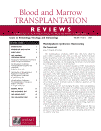Myelodysplastic Syndromes: Rejuvenating the Senescent
by John R. Wingard, Editor
The myelodysplastic syndromes (MDS) have often been called the poster child for apoptosis gone awry: in some cases death (to hematopoietic progenitors) comes too infrequently, in other cases it comes too readily. The quest to better understand its basis and to translate this understanding into therapeutics is only beginning, but already several therapies have emerged and others are in development.
For now, there is only one curative therapy for MDS: hematopoietic cell transplantation (HCT). Indeed, it can be argued that the pivotal clinical decision for each patient with MDS is whether HCT should be offered and if so when. Critical elements of the decision include the prognosis and impact of the MDS manifestations facing the patient, the fitness of the patient for HCT, and whether a suitable donor is available. The tempo of the disease process also influences the timing of the transplantation option. For those in whom HCT is not appropriate, supportive care and an increasing array of treatment options to influence apoptosis are the choices to be considered.
Developments in new and emerging therapies, both transplantation and nontransplantation, are the subject of a satellite symposium presented at the 2007 BMT Tandem Meetings in Keystone, Colorado. In the first presentation, Dr. Richard Stone discusses the general approach one should take in making clinical decisions in patients with MDS and discusses the various approaches for different types of MDS. Dr. Joachim Deeg discusses the factors that should be weighed in choosing when to offer transplantation and discusses the expectations one can reasonably anticipate. Dr. Douglas Smith presents some innovative options being explored to improve transplantation outcomes in high-risk disease.
It truly appears that emerging therapies are finally giving new life to an old problem that resisted efforts for decades. These efforts now offer the prospect of improving quality of life for some, extending survival for others, and for some cure.
Download a PDF version of the full issue.

